|
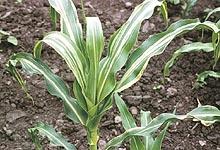
Fig. 1. A corn plant systemically infected by Erwinia stewartii. |
Introduction
For over a 100 years, Stewart’s bacterial wilt (Fig. 1) periodically has been a concern for sweet corn growers and field corn seed producers. Even though the disease was more widespread than usual during the past decade, the impact of disease was minimized because of past and present research that has resulted in resistant hybrids, an adequate warning system, and other control tactics that complement resistance.
In the late 1880s, a new bacterial disease of corn was described from fields in southern Illinois by T. J. Burrill, whose work on fire blight was instrumental in establishing the concept that plant diseases could be caused by bacteria. Burrill and an entomologist, S. A. Forbes, associated the occurrence of these corn disease symptoms with tissues from which bacteria were observed, dry conditions, and large populations of chinch bugs. Despite isolating bacteria from symptomatic plants and insects, Burrill was unable to complete Koch’s postulates, and Burrill’s description of plants suffering from this affliction included many symptoms that are not attributed currently to Stewart’s wilt.
In 1895, F. C. Stewart first observed a bacterial wilt of sweet corn on Long Island, New York. Stewart gave an accurate account of the symptoms, isolated the bacterium, and reproduced the symptoms by inoculating sweet corn with the isolated bacterium. Stewart believed the disease was confined entirely to sweet corn, and thus was undoubtedly different from the disease that Burrill described from field corn. A culture of the bacterium was sent to E. F. Smith who in 1898 described and named the organism Pseudomonas stewartii to honor Stewart. The diseases subsequently became known as Stewart’s wilt. After several name changes the pathogen was given its current name, Erwinia stewartii, in 1963, although another name change (Pantoea stewartii) has been proposed recently.
Symptoms and Signs
Two phases of Stewart’s wilt occur on corn. The seedling wilt phase occurs when susceptible corn is infected systemically as young plants (Fig. 2). The leaf blight phase occurs when plants are infected after tassels emerge (Fig. 3). During both phases of the disease, infection occurs when plant tissues are wounded during feeding by corn flea beetles (Chaetocnema pulicaria) (Fig. 4). Corn flea beetles are the overwintering host and vector of Erwinia stewartii (Fig. 5).
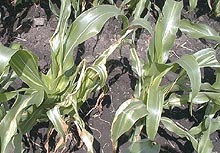 |
|
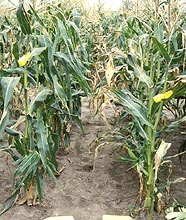 |
|
|
Fig. 2. The seedling wilt phase of Stewart’s wilt occurs when seedlings are systemically infected by Erwinia stewartii. |
|
Fig. 3. The leaf blight phase of Stewart’s wilt on two sweet corn hybrids with different levels of host resistance: moderately resistant (left), moderately susceptible (right). |
|
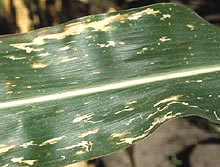 |
|
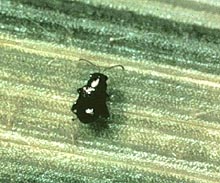 |
|
Fig. 4. Flea beetle feeding wounds on corn leaves. |
|
Fig. 5. The corn flea beetle (Chaetocnema pulicaria) is the overwintering host and vector of Erwinia stewartii. |
Early symptoms on leaves are similar for the seedling wilt and leaf blight phases of this disease. Leaf tissue surrounding flea beetle feeding wounds initially become water-soaked. After initial infection, pale-green to yellow linear streaks with irregular or wavy margins develop parallel to leaf veins (Fig. 6). These lesions may extend the entire length of the leaf on susceptible cultivars. Water-soaked and chlorotic tissues become necrotic with age. If infection becomes systemic, distinct symptoms appear on new leaves emerging from the plant whorl. Tassels may appear to be bleached due to premature death, and cavities may form in the stalks near the soil line (Fig. 7) if plants are infected systemically. Bacteria spread throughout the vascular system of systemically infected plants and occasionally infect kernels. In resistant cultivars, symptoms usually are limited to within 2 to 3 cm surrounding flea beetle feeding wounds and systemic infection occurs rarely, if ever. A range of reactions to Stewart’s wilt occurs among different lines of corn (Fig. 8). If infection occurs when seedlings are emerging, main stalks can be killed which may result in profuse growth of tillers (Fig. 9). Although it has not been demonstrated experimentally, main stalk death probably results from infection of the primary growing point when flea beetles transmit E. stewartii while feeding on emerging coleoptiles or very young seedlings.
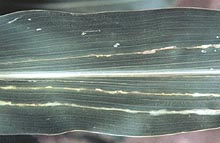 |
|
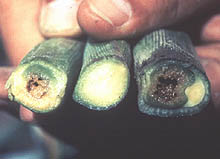 |
|
Fig. 6. Typical leaf symptoms of Stewart’s wilt: pale-green to yellow linear streaks with irregular or wavy margins that run parallel to leaf veins. Water-soaked and chlorotic tissues turn necrotic with age. |
|
Fig. 7. Cavities may form near the soil line in the stalks of plants systemically infected by Erwinia stewartii. |
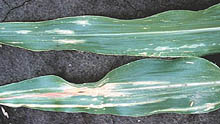
A |
|
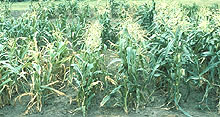
B |
Fig. 8. A range of reactions to Stewart’s wilt occurs among different corn lines. A: Movement of E. stewartii is limited in leaf tissue of lines with moderate resistance (top) compared to lines that are moderately susceptible (bottom). B: The degree of stunting and the amount of symptomatic leaf area differs substantially among 2-row plots of sweet corn hybrids that are susceptible (left), intermediate (middle), and resistant (right) to Stewart’s wilt.
| |
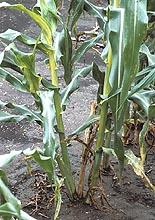
Fig. 9. Main stalks can be killed if plants are infected by Erwinia stewartii at the time of emergence. When main stalks are killed, tillers often begin to grow profusely. |
|
Foliar symptoms of the leaf blight phase are similar to those of the seedling wilt phase. Chlorotic or necrotic tissues may extend the entire length of leaves, or symptoms may be limited to a few centimeters depending on the resistance or susceptibility of the cultivar. Premature leaf death due to Stewart’s wilt may predispose the weakened plant to stalk rot resulting in reduced yields.
Other diseases and conditions can produce leaf symptoms that are similar to those of Stewart’s wilt (Fig. 10). However, a simple microscopic examination of leaf tissue for bacterial ooze can easily differentiate Stewart’s wilt from other disorders with similar symptoms (Fig. 11).
| |
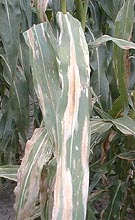
Fig. 10. Coalesced lesions of northern corn leaf blight (NCLB), caused by Exserohilum turcicum, can resemble the leaf symptoms of Stewart’s wilt. |
|
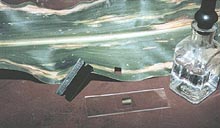
A |
|

B |
Fig. 11. A simple microscopic examination of symptomatic leaf tissue for bacterial ooze can be used to diagnose Stewart’s wilt easily. A: A section of symptomatic leaf tissue is placed in a drop of water on a microscope slide. B: When viewed with a compound microscope, bacteria appear to ooze from xylem vessels of plants infected with E. stewartii.
Stewart’s wilt has little effect on yield of resistant field corn hybrids grown in North America, but it can substantially reduce yields of susceptible sweet corn hybrids. Stewart’s wilt also can have an economic impact on seed trade because of quarantine restrictions and/or costs associated with breeding for resistance. In the midst of severe epidemics in the early-1930s, Stewart’s wilt was largely responsible for the development and enthusiastic acceptance of the first widely-grown, single-cross corn hybrid, Golden Cross Bantam.
Significance
In field corn, yield losses due to Stewart’s wilt have been inconsequential in North America for the past 50 years, except for a few small, sporadic outbreaks. The minimal economic impact of Stewart’s wilt on field corn is primarily due to adequate levels of resistance incorporated into corn hybrids that are grown where the disease occurs although some early-maturing field corn lines are moderately susceptible. Prior to the development of resistant hybrids, Stewart’s wilt caused notable economic losses, particularly during epidemics in the early 1930s.
In sweet corn, economic losses due to Stewart’s wilt continue to be notable because susceptible or moderately susceptible hybrids are grown periodically in areas where flea beetles occur. Yield losses in sweet corn due to Stewart’s wilt are affected by the level of resistance or susceptibility of the hybrid and by the growth stage at which plants are infected (Table 1). Yield is not adversely affected or yield losses are minimal in resistant and moderately resistant hybrids; however, losses frequently range from 40 to 100% when susceptible sweet corn hybrids grown under epidemic conditions are infected prior to the 5-leaf stage. Yield losses in sweet corn are related to systemic infection. Yield is reduced about 0.8% for each 1% incidence of plants infected systemically as seedlings (Fig. 12).
Table 1. Potential effects of Stewart's wilt on yield losses in sweet corn. (Suparyono & Pataky, 1989.)
| Hybrid reaction |
Growth stage when infected |
3- to 5-
leaf |
5- to 7-
leaf |
7- to 9-
leaf |
| R |
0% |
0% |
0% |
| MR |
0-30% |
0% |
0% |
| MS |
10-40% |
0-20% |
0% |
| S |
40-100% |
15-35% |
3-15% |
Prior to 3-leaf stage, main stalks may be killed.
| |
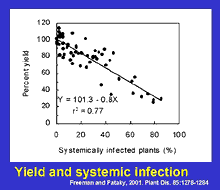
Fig. 12. Stewart’s wilt reduces yield of sweet corn by about 0.8% for each 1% incidence of plants infected systemically as seedlings. |
|
Stewart’s wilt also can have an economic impact on seed trade as a result of phytosanitary regulations imposed by trading partners. Phytosanitary regulations for Erwinia stewartii primarily affect seed commerce by preventing seed from being exported or by creating additional costs for phytosanitary inspections prior to export. Stewart’s wilt also creates indirect costs for seed producers because resources must be used to screen germplasm and breed corn for Stewart’s wilt resistance in order to develop hybrids that efficiently and effectively control the disease.

Fig. 13. Glen Smith, a USDA scientist with the Purdue University Department of Botany and Plant Pathology (1919-1958), developed the first widely-grown, single-cross corn hybrid, Golden Cross Bantam. The enthusiastic acceptance of this new type of sweet corn was due, in part, to Stewart’s wilt resistance. (Photo courtesy of G. Shaner, Purdue University.) |
|
The first great economic contribution of hybrid sweet corn occurred in the early 1930s when the first widely-grown single-cross corn hybrid, Golden Cross Bantam, was released, in part, to control Stewart’s wilt. In 1923, Glenn Smith, a USDA scientist working in the Department of Botany and Plant Pathology at Purdue University (Fig. 13), began inbreeding lines from a popular, open-pollinated sweet corn cultivar, Golden Bantam. Like many early-maturing sweet corn cultivars derived from Northern Flint corn, Golden Bantam was extremely susceptible to Stewart’s wilt (Fig. 14). In 1930, Smith tested his first set of Golden Bantam hybrid crosses in the midst of one of the most destructive epidemics of Stewart’s wilt ever experienced in northern Indiana. Two of Smith’s inbred lines (P39 and P51) that were derived from two different versions of Golden Bantam combined to produce a single-cross hybrid that was resistant to Stewart’s wilt (Fig. 15). Following a second year of successful performance during another Stewart’s wilt epidemic in 1931, the hybrid was named Golden Cross Bantam. Within a few years after it was released in 1932, Golden Cross Bantam had virtually revolutionized the sweet corn canning industry, and 70 to 80% of all sweet corn canned in the US was Glenn Smith’s Stewart’s wilt-resistant hybrid.
| |
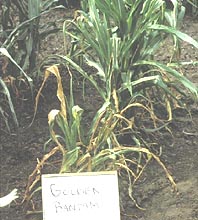 |
|
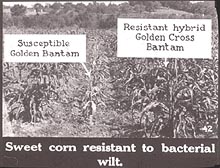 |
|
| |
Fig. 14. The open-pollinated cultivar Golden Bantam which was grown widely in the 1920s and early 1930s was extremely susceptible to Stewart’s wilt. A Stewart’s wilt resistant hybrid Golden Cross Bantam was created from two inbred lines, P39 and P 51, that were developed from Golden Bantam by Glenn Smith, a USDA plant pathologist at Purdue University. |
|
Fig. 15. The Stewart’s wilt resistant sweet corn hybrid, Golden Cross Bantam, was the first single cross corn hybrid to be grown extensively. Derived from a Stewart’s wilt susceptible, open-pollinated cultivar Golden Bantam, Golden Cross Bantam was superior to the open-pollinated cultivar for resistance, uniformity, yield and quality. (Photo from a USDA film strip.) |
|
Fifteen years after his remarkable accomplishment, Smith modestly commented on his work in The Hybrid Corn Makers, “Our project was well planned, and I just carried out the work as best I could. Some of it, to be sure, was monotonous, but take the job as a whole and it has been a lot of fun. I shall never cease to be thankful that we had that epidemic of bacterial wilt from 1930 until 1933, for without that bit of good luck we might never have discovered the possibilities of Golden Cross Bantam.” In additional to Stewart’s wilt resistance, the “possibilities of Golden Cross Bantam” included uniformity that was unknown among sweet corn cultivars prior to the development of hybrids. Even in comparison to field corn hybrids of the 1930s (most of which were three-way or double-cross hybrids produced from three or four inbred parents), Golden Cross Bantam was more uniform because it was a single-cross hybrid produced from two inbred parents. Stewart’s wilt resistance, uniformity, superior yield, and eating quality combined to make this new variety of “hybrid corn” extremely popular among sweet corn processors well into the 1950s. Sweet corn inbred lines with P39 and P51 in their backgrounds continue to be used as parents of sweet corn hybrids grown today, and resistance to Stewart’s wilt continues to be an essential attribute of sweet corn hybrids grown in areas where the disease occurs in order to prevent notable reductions in yield (Fig. 16).
| |
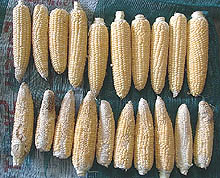
Fig. 16. Sweet corn hybrids with resistance to Stewart’s wilt (top) are grown in areas where the disease is prevalent in order to prevent substantial reductions in yield that may occur if susceptible hybrids are grown (bottom). |
|
Pathogen Biology
Erwinia stewartii is a facultative anaerobic, gram-negative, nonflagellate, nonspore-forming, nonmotile rod-shaped bacterium measuring approximately 0.4 to 0.8 × 0.9 to 2.2 µm. Culture media affects colony color and growth. Colonies on yeast extract-dextrose-calcium carbonate agar are yellow and convex. Colonies on nutrient-glucose agar are cream-yellow to orange-yellow. Pathogenicity of E. stewartii is related to the production of extracellular polysaccharides that contribute to occlusion of xylem vessels and symptom development. Production of capsular polysaccharides, and hence pathogenicity, require quorum-sensing regulatory proteins. Pathogenicity and the appearance of water-soaked symptoms also require a hypersensitive response and pathogenicity (hrp) and water-soaking (wts) gene cluster which is substantially homologous with a hrp gene cluster found in Erwinia amylovora, the bacterium that causes fire bight.
Erwinia stewartii is closely related to other bacteria in the Erwinia herbicola-Enterobacter agglomerans complex. The taxonomy of this pathogen was debated throughout the first half of the 20th century until D. W. Dye proposed Erwinia stewartii as the correct Latin binomial in 1963. Prior to this, the bacterium was named: Pseudomonas stewartii, Bacterium stewartii, Aplanobacter stewartii, Bacillus stewartii, Phytomonas stewartii, Xanthomonas stewartii, and Pseudobacterium stewartii. Recently, the nomenclature of the genus Erwinia has been modified again based on chemotaxonomic and molecular approaches. However the taxonomic complexity of this group has not been completely resolved and a dual system of nomenclature is in use presently. The genus Pantoea was proposed for some strains of the Erwinia herbicola-Enterobacter agglomerans complex, including E. stewartii. However separation of this group from other Erwinia species is not fully supported by some approaches, such as 16S RNA sequence analysis. Thus, the pathogen continues to be referred to by two Latin binomials, Pantoea stewartii and Erwinia stewartii.
In comparison to other bacteria, E. stewartii appears to be a relatively homogeneous organism that has become adapted to surviving primarily in two hosts, corn and the corn flea beetle, Chaetocnema pulicaria. By occupying these two specialized niches, populations of E. stewartii have been selected for much greater similarity than non-specialist Erwinias, such as E. hebricola and E. carotovora, which are ubiquitous in nature and much more phenotypically diverse than E. stewartii.
Disease Cycle and Epidemiology
F. C. Stewart suggested that the bacterium was disseminated by seed. It was not until twenty-five years later, in 1923, that F. V. Rand and Lillian Cash implicated the corn flea beetle, Chaetocnema pulicaria, as the primary vector responsible for the mid-season spread of the leaf blight phase of the disease. The ability of the pathogen to overwinter primarily in the insect vector rather than in seed was established by F. W. Poos and Charlotte Elliott in 1934.
Erwinia stewartii appears to survive primarily in two hosts, corn and the corn flea beetle, Chaetocnema pulicaria. The bacterium is transmitted almost exclusively by corn flea beetles, and there are no known examples of widespread, prolonged occurrences of Stewart’s wilt in the absence of this insect. Although the disease has been reported infrequently from various parts of the world, the bacterium has never become established outside of the region of North America where the vector occurs. In the United States, Stewart’s wilt is endemic in the mid-Atlantic and the Ohio River Valley regions and in the southern portion of the Corn Belt, including portions of Connecticut, Delaware, Illinois, Indiana, Iowa, Kentucky, Maryland, Missouri, New Jersey, New York, Ohio, Pennsylvania, Rhode Island, Virginia, and West Virginia (Fig. 17). The occurrence of Stewart’s wilt in other eastern and midwestern states and in portions of Canada coincides with the occurrence of corn flea beetles.
| |
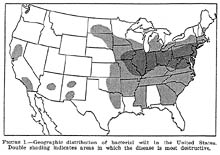
Fig. 17. The present geographic distribution of Stewart’s wilt in the United States is similar to the distribution reported in the early 1940s. (Illustration from: Elliott, C. 1941.) |
|
Erwinia stewartii overwinters in the alimentary tract of corn flea beetles. These insects emerge from hibernation in the spring when soil surface temperatures reach about 65 to 70°F (18 to 21°C). Flea beetles feed on young corn plants and transmit E. stewartii. The bacteria are unable to spread from plant to plant without this vector. Although bacteria are present in regurgitated material and in feces of C. pulicaria, the most probable mode of infection appears to be from fecal contamination of feeding wounds. Two or more summer generations of flea beetles develop during the growing season. The first summer generation peaks about mid-June and a second generation occurs about 4 to 6 weeks later. Two cycles of Stewart’s wilt infection coincide with peak populations of flea beetles. The first cycle of Stewart’s wilt is the most damaging because seedlings are infected by E. stewartii that is transmitted by the overwintering generation of flea beetles. The second cycle of infection occurs when the bacteria are transmitted by the first summer generation of the insect. The second cycle of infection usually causes the leaf blight phase of Stewart’s wilt in field corn, but it can cause the seedling wilt phase in late-planted crops of sweet corn. Subsequent generations of flea beetles acquire the bacterium from infected plants and become the overwintering population that infects the next year’s crop.
Stewart’s wilt was one of the first plant diseases for which a disease forecast system was developed. By comparing maps of winter temperatures and Stewart’s wilt occurrence in the midwestern and eastern United States in the early 1930s, N. E. Stevens developed a system to predict the occurrence of Stewart’s wilt based on a winter temperature index. Fifteen years later, G. H. Boewe modified Steven’s forecast to more accurately predict the leaf blight phase of Stewart’s wilt (Table 2). The Stevens-Boewe forecast can be simplified further by dividing the winter temperature index by 3 to approximate the average winter temperature. If the average daily temperature for December, January, and February is above freezing, > 33°F (1°C), flea beetles survive and Stewart’s wilt is likely to be severe on susceptible hybrids. If the average daily temperature is less than 27°F (-3°C), flea beetles are not likely to survive, and it is unlikely that Stewart’s wilt will be severe. The Stevens-Boewe system is an imperfect predictor, but it can be used as a guideline to advise growers of the potential for Stewart’s wilt in the coming season (Fig. 18). Severe outbreaks of Stewart’s wilt in the Midwest and eastern United States in the early-1930s, early-1950s, and 1990s followed winters that were among the warmest of the 20th century.
Table 2. Sevens-Boewe forecast for Stewart's wilt. Developed in the 1930s and revised in the 1940s by N. E. Stevens and G. H. Boewe at the Illinois Natural History Survey, University of Illinois.
| Winter temp index |
Seedling wilt phase |
Leaf blight phase |
| 100 or more |
destructive |
severe |
| 90 to 100 |
light to severe |
severe |
| 85 to 90 |
nearly absent |
moderate |
| 80 to 85 |
nearly absent |
light |
| below 80 |
nearly absent |
trace |
Winter temperature index = sum of average temperature (°F) for December, January, and February.
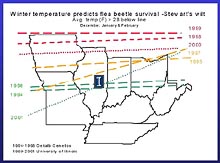
A |
|
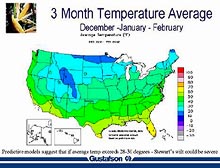
B |
Fig. 18. Various types of maps that depict average temperatures in December, January, and February can be used as a guideline to determine areas where Stewart’s wilt is likely to be a potential problem. A: The area in the Midwest where Stewart’s wilt has the potential of being a problem in a particular year (i.e., the area south of each line) is depicted by a map that shows the approximate northern boundary for an average winter temperature of 28°F. B: A more detail weather map generated by the NOAA Climate Prediction Center was used by Gustafson Inc. to predict areas where Stewart’s wilt had the potential to be severe in 2002.
Although E. stewartii can be seed-borne, seed transmission plays an insignificant role in the epidemiology of Stewart’s wilt in North America where the disease occurs normally. Outside of North America, over 60 countries place quarantine restrictions on corn seed to prevent the introduction of E. stewartii.
The resistance or susceptibility of the seed parent plant greatly affects whether or not seed from infected plants will harbor E. stewartii. If seed parent plants are infected systemically during the seedling wilt phase, seed may be infected with E. stewartii. If the leaf blight phase of Stewart’s wilt occurs but seed parent plants are not infected systemically, seed transmission is extremely unlikely. Some of the research on seed transmission of E. stewartii in the first half of the 20th century did not consider reactions of seed parent plants and/or the occurrence of vectors; and therefore, rates of seed transmission were overestimated for nearly 60 years. Based on recent research on plant-to-seed and seed-to-seedling transmission, rates of transmitting E. stewartii in seed appear to be about 1 in 50,000 for seed produced on systemically infected, susceptible seed parent plants and 1 in 20,000,000 for seed produced on resistant plants with symptoms of the leaf blight phase of Stewart’s wilt.
Managing Stewart’s Wilt
Throughout North America, Stewart’s wilt is controlled effectively by planting resistant corn hybrids. Resistance restricts the movement of Erwinia stewartii in the vascular system of plants and prevents plants from becoming infected systemically. Thus, levels of resistance or susceptibility in a hybrid affect the frequency of systemically infected plants (Fig. 19). Most field corn hybrids have highly resistant to moderately resistant reactions to Stewart’s wilt, whereas reactions of sweet corn hybrids range from resistant to highly susceptible. Stewart’s wilt resistance is inherited relatively simply and can be selected easily in a breeding program. Plant breeders and pathologists typically inoculate plants with E. stewartii or rely on natural infection in order to select plants with mild symptoms (Fig. 20). If a hybrid has a level of Stewart’s wilt resistance that prevents systemic infection, economic damage from the disease (e.g., yield losses) rarely occurs (Fig. 21).
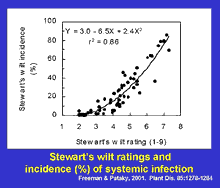 |
|
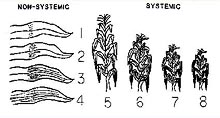 |
|
Fig. 19. Among sweet corn hybrids, the incidence (%) of systemically infected plants is curvilinearly related to Stewart’s wilt ratings. Hybrids with moderate reactions (ratings from 3 to 4.5) have few systemically infected plants whereas systemic infection is more frequent among hybrids that are more susceptible (ratings above 5). |
|
Fig. 20. A 1 to 9 scale was developed for rating a range of plant reactions to Stewart’s wilt (1 = very little movement of E. stewartii from infection sites, 9 = dead plants). Plant breeders and pathologists select materials that have non-systemic reactions (ratings below 3.5 on this scale) in order to develop corn lines with levels of Stewart’s wilt resistance that prevent or greatly inhibit yield losses. |
| |
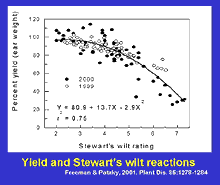
Fig. 21. Reductions in sweet corn yield (ear weight) are related to severity of Stewart’s wilt infection. If infection is not systemic (i.e., ratings below 3.5) yield is affected minimally. |
|
In some situations, growers prefer to plant hybrids with moderate or susceptible reactions to Stewart’s wilt because these hybrids are superior for other important characteristic. For example, many fresh market sweet corn growers plant early-maturing hybrids that are moderately susceptible or susceptible to Stewart’s wilt in order to be able to harvest early when prices are high. In this situation, Stewart’s wilt can be managed by controlling corn flea beetles. Seed treatment insecticides (e.g., clothianidin, imidicloprid, thiamethoxam) can protect plants from infection by killing the insect vector before the bacterium is transmitted. Insecticides applied in-furrow at planting or insecticides applied as foliar treatments after seedlings emerge also control flea beetles, although the ability of in-furrow or foliar insecticides to manage Stewart’s wilt has been somewhat more erratic than seed treatment insecticides.
Infected seed is unimportant in the epidemiology of Stewart’s wilt in areas where the disease is endemic; however, the bacterium can be excluded from areas where it does not already occur by ensuring that seed is disease-free. The probability of transmitting E. stewartii in seed is extremely low, but over 60 countries place some type of quarantine restriction on corn seed to prevent the introduction of E. stewartii.
Producing seed in areas where Stewart’s wilt does not occur ensures that E. stewartii will not be introduced on seed. For example, most sweet corn seed is produced in Idaho where Stewart’s wilt normally does not occur. Therefore, it is nearly impossible to introduce E. stewartii on sweet corn seed produced in Idaho, even if the hybrid is extremely susceptible. In the Midwest, where most field corn seed is produced, visual inspections of seed production fields for symptoms of systemic Stewart’s wilt infection can provide a qualitative assessment of whether or not seed may harbor E. stewartii. If seed parent plants are not infected systemically, the probability of introducing E. stewartii on seed is nearly zero. If some plants are systemically infected with Stewart’s wilt in seed production fields, an approved seed health test can be used to detect E. stewartii-infected seed. A seed health test based on an enzyme-linked immunosorbent assay (ELISA) and an appropriately large sample of seed has been approved by the USDA National Seed Health System to ensure at a known probability that E stewartii-seed infection is below an accepted threshold (Fig. 22).
| |
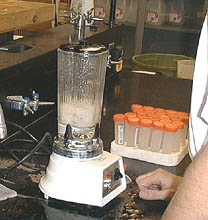
A |
|
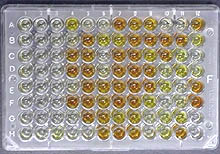
B |
|
Fig. 22. An approved ELISA-based seed health test can be used to detect Erwinia stewartii in corn seed. A: Four 100-kernel samples of seed are soaked in a buffer solution and blended before samples are tested for E. stewartii with an enzyme-linked immunosorbent assay (ELISA). B: Seed samples that harbor E. stewartii are detected by causing a change in color of solutions in ELISA plate wells.
Conclusion
Stewart’s wilt will continue to be present when warm winters favor the survival of the corn flea beetle vector of Erwinia stewartii. In North America, the disease will be controlled by improved levels of resistance from sources that have been shown by molecular mapping to carry different genes for resistance, and by control tactics that complement resistance, i.e., seed treatment insecticides. Countries importing corn seed from the US also can be more assured that E. sterwartii will not be introduced in seed as a result of recent research on seed transmission and improved methods of detecting E. stewartii in seed.
Additional Resources
UI sweet corn hybrid disease nursery
Reports on Plant Diseases No. 201 - Stewart's Leaf Blight of Dent Corn
Cornell Vegetable MD On-line
Stewart’s disease - Iowa State
Stewart’s disease images - Iowa State
Corn Flea Beetle: Chaetocnema pulicaria
Pest risk analysis for Erwinia stewartii in maize seed
Compound direct ELISA test system for Erwinia stewartii
Selected References
Boewe, G. H. 1949. Late season incidence of Stewart’s disease on sweet corn and winter temperatures in Illinois, 1944-1948. Plant Dis. Rep. 33:192-194.
Braun, E. J. 1982. Ultrastructural investigation of resistant and susceptible maize inbreds infected with Erwinia stewartii. Phytopathology 72:159-166.
Crabb, A. R. 1947. The hybrid-corn makers: Prophets of plenty. Rutgers University Press, New Brunswick, NJ.
Elliott, C. 1941. Bacterial wilt of corn. USDA Farmer’s Bull. No. 1878.
Freeman, N. D., and Pataky, J. K. 2001. Levels of Stewart’s wilt resistance necessary to prevent reductions in yield of sweet corn hybrids. Plant Dis. 85:1278-1284.
Lamka, G. L., Hill, J. H., McGee , D. C., Braun, E. J. 1991. Development of an immunosorbent assay for seedborne Erwinia stewartii in corn seeds. Phytopathology 81:839-846.
Pataky, J., and Ikin, R. 2003. The risk of introducing Erwinia stewartii in maize seed. Online. A pest risk analysis prepared for the International Seed Federation, Nyon, Switzerland.
Pataky, J. K., Michener, P. M., Freeman, N. D., Weinzierl, R. A., and Teyker, R. 2000.Control of Stewart’s wilt in sweet corn with seed treatment insecticides. Plant Dis. 84:1104-1108.
Pepper, E. H. 1967. Stewart's bacterial wilt of corn. Monogr. 4. American Phytopathological Society. St. Paul, MN.
Smith, G. D. 1933. Golden Cross Bantam. USDA Agr. Circ. 268.
Stevens, N. E. 1934. Stewart's disease in relation to winter temperatures. Plant Dis. Rep. 18:141-149.
Stewart, F. C. 1897. A bacterial disease of sweet corn. N.Y. Agric. Exp. Sta. Bull. 130:422-439.
Suparyono and Pataky, J. K. 1989. Influence of host resistance and growth stage at the time of inoculation on Stewart's wilt and Goss' wilt development and sweet corn hybrid yield. Plant Dis. 73:339-345.
